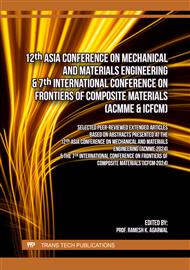[1]
J. Bolden, T. Abu-Lebdeh, and E. Fini: Am. J. Environ. Sci. Vol. 9, no. 1 (2013), p.14–24.
Google Scholar
[2]
H. M. Hamada, B. A. Tayeh, A. Al-Attar, F. M. Yahaya, K. Muthusamy, and A. M. Humada: J. Build. Eng. Vol. 32 (2020) p.101583.
DOI: 10.1016/j.jobe.2020.101583
Google Scholar
[3]
A. Rehman, K. A. Khan, T. Hamid, H. Nasir, I. Ahmad, and M. Alam: Civ. Eng. J. Vol. 6, no. 2 (2020), p.238–257.
Google Scholar
[4]
H. Song, A. Ahmad, K. A. Ostrowski, and M. Dudek: Materials (Basel) Vol. 14, no. 16 (2021), p.4518.
Google Scholar
[5]
P. Shafigh, H. Bin Mahmud, M. Z. Jumaat, and M. Zargar: Constr. Build. Mater. Vol. 53 (2014), p.110–117.
Google Scholar
[6]
M. I. Albiajawi, R. Embong, and K. Muthusamy: Mater. Today Proc. Vol. 48 (2022), p.778–783.
Google Scholar
[7]
S. Luhar, T. W. Cheng, and I. Luhar: Compos. Part B Eng. Vol. 175 (2019), p.107076.
Google Scholar
[8]
J. Zhan, J. Lu, and D. Wang: Rev. Aquac. Vol. 14, no. 1 (2022), p.477–488.
Google Scholar
[9]
N. Saikia and J. De Brito: Constr. Build. Mater. Vol. 34 (2012), p.385–401.
Google Scholar
[10]
S. Bahij, S. Omary, F. Feugeas, and A. Faqiri: Waste Manag. Vol. 113 (2020), p.157–175.
DOI: 10.1016/j.wasman.2020.05.048
Google Scholar
[11]
K. Kishore and N. Gupta: Mater. Today Proc. Vol. 26 (2020), p.2926–2931.
Google Scholar
[12]
M. M. Attia, B. A. Abdelsalam, M. Amin, I. S. Agwa, and M. F. Abdelmagied: Buildings Vol. 12, no. 8 (2022), p.1120.
Google Scholar
[13]
N. Chand, P. Sharma, and M. Fahim: Wear Vol. 269, no. 11–12 (2010), p.847–853.
Google Scholar
[14]
K. Sakr: J. Mater. Civ. Eng. Vol. 18, no. 3 (2006), p.367–376.
Google Scholar
[15]
I. S. Mustafa, N. N. Razali, A. Ibrahim, N. Yahaya, and H. M. Kamari: J. Intelek Vol. 9, no. 2 (2016), pp.1-6.
Google Scholar
[16]
F. R. P. Plando, M. B. Z. Gili, and J. T. Maquiling: Radiat. Phys. Chem. Vol. 208 (2023), p.110916.
Google Scholar
[17]
I. Y. Hakeem, I. S. Agwa, B. A. Tayeh, and M. H. Abd-Elrahman: Case Stud. Constr. Mater. Vol. 17 (2022), p. e01486.
Google Scholar
[18]
A. Naqi, S. Siddique, H. K. Kim, and J. G. Jang: Constr. Build. Mater. Vol. 230 (2020), p.116973.
Google Scholar
[19]
S. Liu, Y. Zhang, B. Liu, Z. Zou, Q. Liu, Y. Teng, and L. V. Zhang: Materials (Basel). Vol. 15, no. 14 (2022), p.4886.
Google Scholar
[20]
H. N. Ruslan, K. Muthusamy, S. M. Syed Mohsin, R. Jose, and R. Omar: Mater. Today Proc. Vol. 48 (2022), p.713–719.
DOI: 10.1016/j.matpr.2021.02.208
Google Scholar
[21]
ASTM International, "C31/C31M - Standard Specification for Making and Curing Concrete Test Specimens in the Field," in Annual Book of ASTM Standards, Vol. 04:01, West Conshohocken, PA, 2019, p.1–6.
Google Scholar
[22]
ASTM International, "C39/C39M Standard Test Method for Compressive Strength of Cylindrical Concrete Specimens," West Conshohocken, PA, 2016. Information on https://www.astm.org/c0039_c0039m-16.html
Google Scholar
[23]
ASTM International, "C496/C496M Standard Test Method for Splitting Tensile Strength of Cylindrical Concrete Specimens," West Conshohocken, PA, 2017. Information on https://www.astm.org/c0496_c0496m-17.html
Google Scholar



